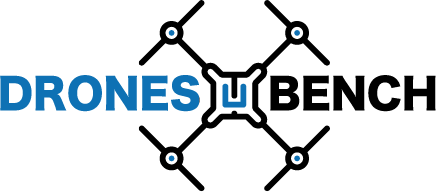Questions and answers
What is the DronesBench testing machine for?
It is used to carry out measurements on the drone in motion, staying fixed to the bench by laces, for certification, performance evaluation, and troubleshooting.
What is the difference between the advanced DronesBench measures and the classic telemetry measures?
The measurements provided by the bench complete and verify the ordinary measurements provided by telemetry on the ground. If the most advanced telemetry can also measure the electric power used by the drone, yet no feedback can be given on the forces exerted by the aircraft itself. The potential of DronesBench is being able to measure forces and powers on the ground, in quasi-static conditions, that meaning that the forces of inertia and possible atmospheric agents do not add to the forces produced by the drone’s propulsion system. If advanced telemetric parameters are available, DronesBench can be a reference tool to integrate and verify telemetry measurements before the drone takes off, plus all the advantages for safety gained through the use of the DronesBench Index.
Is it possible to measure the thrust of a single engine?
The thrust of the single engine can be obtained with the DronesBench, either with all the engines switched on through a mathematical calculation or with just one engine running and disconnecting the others, as a direct physical result.
Is it possible to measure the propeller torque?
The propeller torque can be obtained from the power and the number of revolutions. The power is read by DronesBench and the number of laps can be read with a speedometer, a small instrument costing a few tens of euros, such as the ‘Micro Tacho’ made by Turnigi.
Is the bench prepared to measure the temperatures of the engines and ESCs?
We use an external IR camera that measures the temperature of all the parts from distance.
Is it possible to measure battery performance in terms of consumption and temperature?
The performance of the battery is very well detected in terms of C, inrush, nominal current and real capacity. In particular, the voltage supplied by the battery to the different current consumption is verified and when the voltage drops below the minimum value, it means that we have exceeded the maximum current. If we give the absorption for a few seconds we are talking about current cues, if the absorption takes minutes we are talking about nominal current. We measure the temperature of the battery with an external IR camera.
Is it possible to put DronesBench in a chamber that simulates extreme weather conditions?
No, the standard DronesBench has currently been tested in standard indoor climate conditions. Our research and development department can develop all the necessary adjustments so that DronesBench can work anywhere.
Why is both the absorbed power and the energy used being measured? Is the energy used deriving from the power measurement or is it actually measured?
Power is an instant parameter, while energy is equal to power multiplied by time. We update energy with every acquisition so it is actually measured with excellent accuracy.
Could you explain to me the meaning of the black dot and the red star that are displayed by the interface software?
The black dot indicates the inclination of the plate in relation to the horizontal, the star indicates the center of gravity of the forces.
I would like to know if it is possible to measure the thrust of the single engine, and the relative propeller torque. Is the bench prepared to measure engine and ESC temperatures? I'm also interested in being able to measure battery performance, in terms of consumption and temperature.
The thrust of the single engine can be obtained by the DronesBench device, either with all the engines switched on through a mathematical calculation or with just one engine running and disconnecting the others, as a direct physical result. The propeller torque can be obtained from the power and the number of revolutions. Battery performance is detected very well both in terms of C and real capacity. For all the temperatures we use an IR camera that measures the temperature of all the parts from distance.
What kind of certification on drones is issued?
The certification states, under signature and responsibility of a technician, a series of technical parameters measured on the drone, the most significant being the FoM for the entire take-off of the drone. This parameter that we call the Dronesbench Index, besides being a quality index of the drone, becomes a reference which we recommend to be put on the drone plate. A variation of this parameter indicates a malfunction of the drone.
To what english categories does the DronesBench technology apply A <20Kg B 20..150Kg C >150? Does DronesBench have the capability to test all three categories?
At the moment we are ready for drones under 20 kg, for other categories we may design a custom device.
You state that ‘For the other categories we may design custom device’ … does this mean that it is your intention to try to create a DronesBench for the 20 – 150kg or above the 150kg?
We prefer to do this custom, on request, so we may ask the customer for his prototype and work on it.
If it is your intention to create a DronesBench for 20 – 150kg, how difficult is it to design DronesBench for this higher weight category?
It is our standard work, I think we are talking about 6 months work at a cost that can be estimated at 100k euros.
In the measure of time how far away is a DronesBench with the capacity to weigh larger Drones?
About 6 months from start.
Does it just require a larger frame or does this mean a complete re-design?
We will use the same principles and take all we can. The new design depends more on the customer’s requirements.
RPAS also informed me that many drone manufactures, especially in the higher end of the market range, have ‘on board motor management systems (OBMMS)’. These OBMMS constantly check and make up to date diagnostics related to the quality of the drone. If the drone has an error then it will not allow itself to be flown.If the drones already have an automatic diagnostic capability does that mean that DronesBench is looking to test only drones that form the low end of the consumer market IE Drones without automatic diagnostic capabilities?
No, the tests inside the drone are generally performed while the drone is flying and sometimes it is too late discover a failure. DronesBench discovers a failure before the flight, at ground level.
New models are under warranty from the manifacturer, usually for a year. I assume that therefore any legal problem or otherwise would have to be settled by the manifacturer as opposed to the purchaser within this first year under warranty. Is this correct?
We fixed some crashed drones and the customers told me that in case of crash the warranty doesn’t work. I’m not sure that this is a general rule, for DJI and for Tali H 500 Walkera it is.
On the DronesBench website, it states that the DronesBench is the first of its kind in the world. Does this mean that DronesBench has no other competition in the market place?
At this stage, I do not know any competitor who has a tool, methods and ideas like ours. I have heard about companies that can certify drones but they don’t show their methods and results publicly. It seems that they treat the drones as any product needing the CE plate. I cannot confirm that because they do not answer to my e-mails.
Does DronesBench have a way of testing that is superior to all other testing equipment on the market?
I cannot compare it with anything else because I don’t know how others work this particular test in detail. If you find something public, please let me know.
Is this unique part of the test called the DBI (DronesBench Index)?
Our novel, academically validated parameter is used to evaluate the coupling propeller-motor. We give this for the whole drone.
What is the advantage of having a test for a drones DBI in comparison te other drone testing already on the market?I don’t know other drone testing that is so complete as dbi on the market. Let me know the reference of other kind of test so i can analyze and answer.
You can use the ‘Factor of Merit’ FoM, which is very well known in the coupling propeller-motor problem, and it is equivalent to our DronesBench Index or DBI.
On the video you say that the test for drones is similar to the test that we have on cars. However even though new regulations relating to Drones was passed through government in the UK in 2017 that requires drone owners to register their drones and to follow the ‘legal drone dode of practice’ there is still no legal requirement for testing the safety of drones in the first category: 0 – 20 kg. Is DronesBench waiting for a change in the laws regarding drones which will make it mandatory to have an annual test?
For now we can just test drones for analysis and improvements. The prospective is to be ready when this will happen.
If your intention is that ‘The prospective is to be ready’ what exactly do you mean by: ready?
Laboratory, man, machine, method. At this stage we have all of these. Ready means that when somebody asks for a certification we are able to give it. For the time being, we can do it for a lot of drones but not for all.
If there is no legal requirement to test the drone what is the incentive to prospective overseas buyers to purchase the DronesBench?
We are pushing EASA with our ideas and they have accepted the idea of certification. As for the methods, we have to wait until the end of the year. That said, we must not forget that testing the drone is an advantage for the customer. If some defect is discovered before flight he saves money, time, bad impression and perhaps some legal implication if somebody is hurt.
What will happen in 2019 for, as you state, the market will be ready?
The European Council is going to approve later this year and implement the new EASA law, which states that certification and periodical checks must be done on some categories of drones. After that, this market will start officially and we will be ready to work at full capacity.

